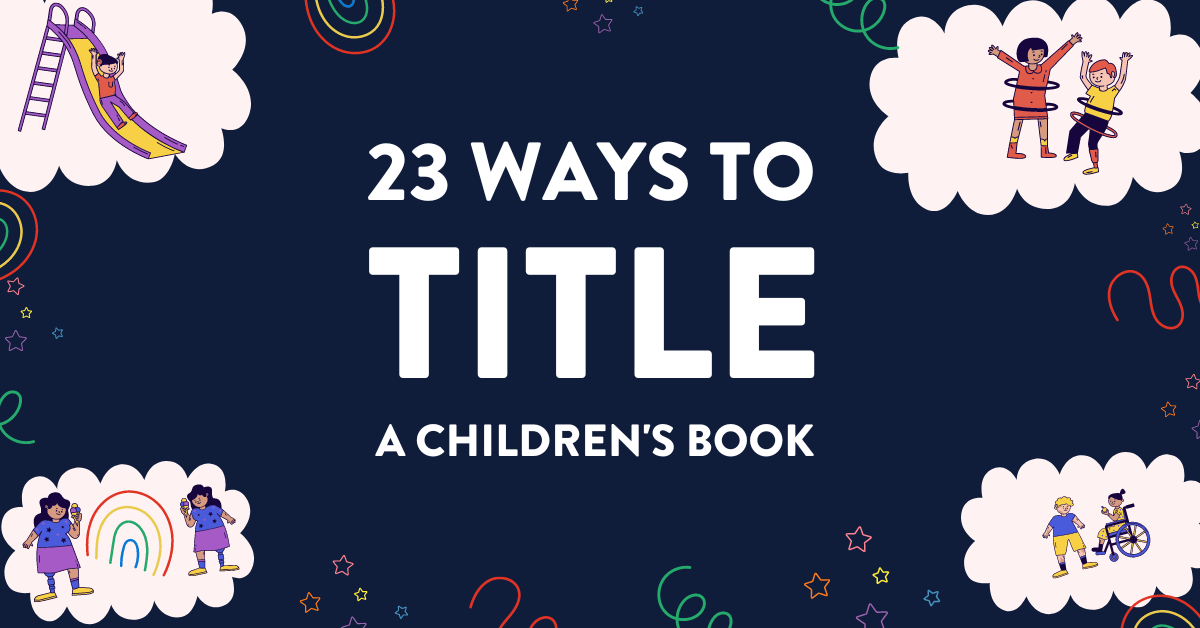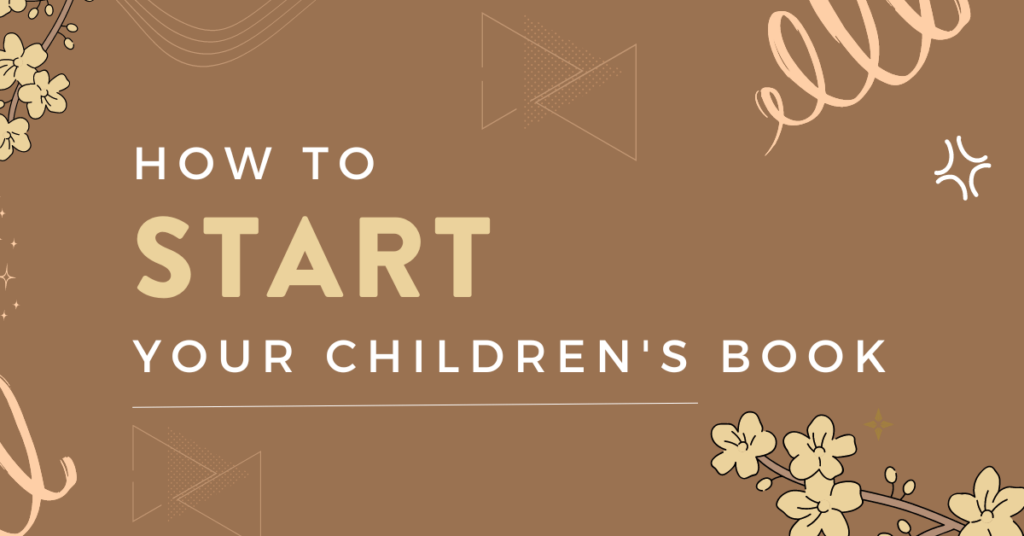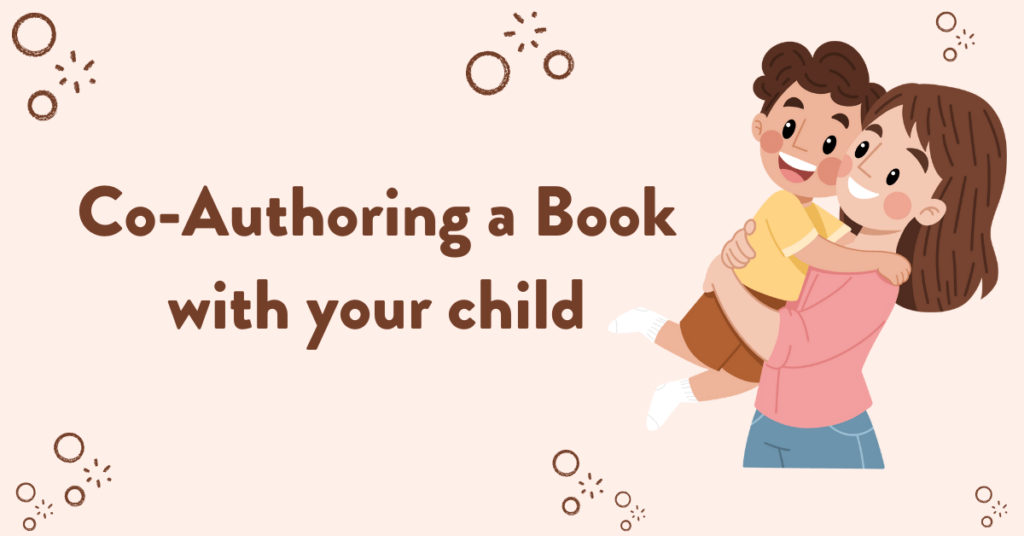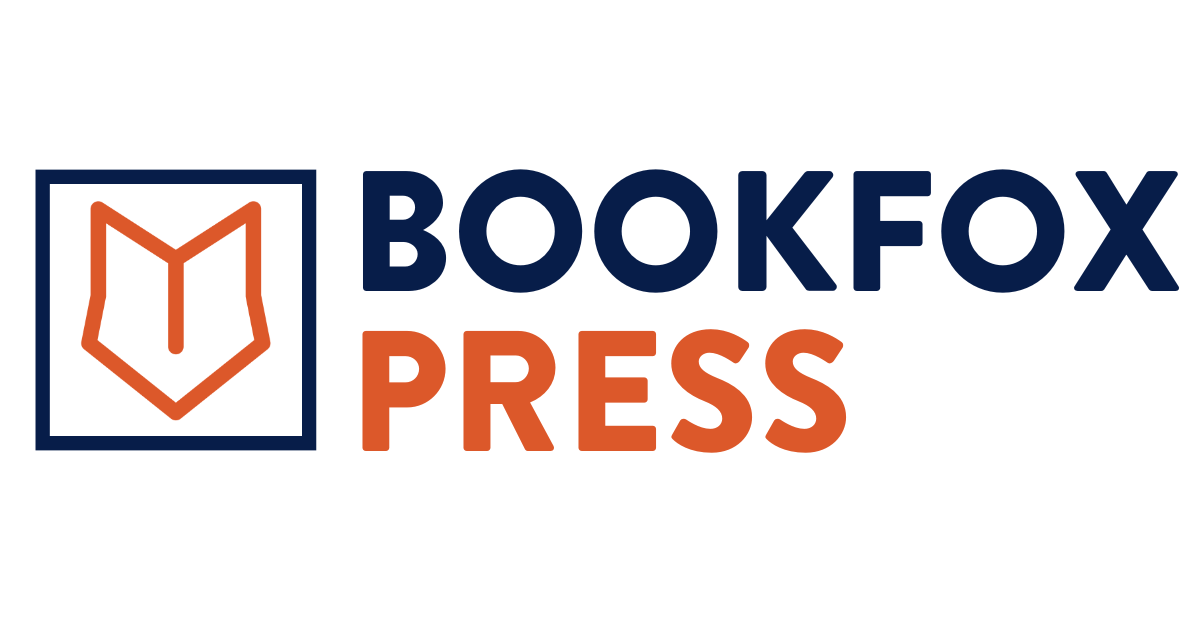
So you’ve gone and done it. You’ve crafted a world filled with whimsy, wonder, and wild adventures, and all that’s left is giving it a name. No big deal, right? Wrong!
Titling your children’s book is like putting the cherry on top of a sundae. You wouldn’t toss just any old cherry up there, would you? Of course not. You’d pick the perfect one.
I’m here to help you find that perfect cherry—err, title. Grab your thinking cap and buckle up. Here’s a step-by-step guide to titling your children’s book like a pro.
Remember, the title is more than just a name; it’s an invitation into the world you’ve created.
If you’re struggling to find that magic touch for your kid’s book, check out my post on how to write a children’s book.
Figure out the Title’s Purpose
Most authors aren’t good at titling their book because they don’t know the purpose of a title.
They think it’s to: tell the reader what the book is about.
Raise your hand if you agree with that. Now lower your hand: you’re wrong.
Well, that’s not exactly wrong, but it’s also not the most important thing a title should do.
If the goal of a book is to tell the reader what the book is about, then “Sally’s Garden” is a fine title:
- We know the book is about Sally
- We know that Sally will do some gardening
But “Sally’s Garden”, while good at communicating the book topic, is extremely uninteresting. What young reader is clamoring to read that? Instead, consider titles like:
- “The Secret Garden”
- “The Magic of the Soil”
- “The Enchanted Plant”
All three of those are using powerful interest words that attract a reader: Secret, Magic, Enchanted.
Three Things a Title Should Do
1. Attract the Right Audience
The title is like a beacon, shining a light for the right readers to find their way to your book. Is your book for toddlers, middle-graders, or young adults? Your title should speak their language.
For instance, if you’ve written an adventurous tale for middle-grade boys, you wouldn’t name it “Bunny’s Naptime,” would you? Of course not! You might opt for something like “The Quest of Thunder Mountain” instead (that has “boy” written all over it).
Titles that resonate with the intended age group will draw them in, like moths to a flame. Misfire on this, and you risk losing your readers before they even crack the cover. If this sounds like a tall order, don’t worry; that’s what editors like me are here for.
2. Get That Audience to Buy the Book
A title’s main job is Marketing (specifically, converting the sale). It’s not enough to simply attract your readers; you’ve got to reel them in. The title must be intriguing enough to make them (or their parents) want to spend their hard-earned cash.
This is where understanding your book’s unique selling points comes in handy. What sets your book apart from the rest?
- Is it a twist on a classic fairy tale?
- A journey to a never-before-seen fantasy land?
- A schoolyard fight that teaches about fairness and forgiveness?
Capture that essence in your title, and you’ll have readers reaching for their wallets.
3. Create a Hunger to Read the Book
So many readers buy books and then don’t read them. You might think this is okay — well, I’ve made a sale — but it’s actually terrible.
- You want them to tell their friends
- You want them to leave a review on Amazon/Goodreads (which helps with sales)
- You want them not to resell it (because it’ll cannibalize new book sales)
Once your audience has the book in hand, the title should ignite a hunger to read. It should whisper promises of excitement, adventure, laughter, or warmth.
You wouldn’t call a rollicking pirate adventure “Sally’s Quiet Day,” would you? No, you’d go for something that screams action and fun like “Sally and the Pirate’s Lost Treasure!”
Strategies for Kidlit Titles
Okay, so now you know what a title should do, we can start discussing some strategies to get there.
Titling a picture book is an art form in itself. But don’t sweat it; there are some tried and true strategies and formulas that you can apply to get the job done. Let’s dig into 23 strategies that you can use for your book.
1. Character + Adventure/Location
- Example: “Tiger Climbs the Mountain”
- Why It Works: By combining the protagonist’s name with a location or adventure, you invite the reader into a specific journey.
2. The One-Word Wonder
- Example: “Splash!”
- Why It Works: A single, evocative word can conjure up an entire world or emotion. Especially effective if that word is central to the story.
3. Rhyming Titles
- Example: “Bears on Chairs”
- Why It Works: Rhymes are catchy and memorable, appealing to young children’s love for rhythm and sound.
4. Ask a Question
- Example: “Where’s My Teddy?”
- Why It Works: A question piques curiosity and encourages the child to explore the book for answers.
5. Use Alliteration
- Example: “Fiona’s Fantastic Flowers”
- Why It Works: Alliteration creates a fun, rhythmic sound, perfect for reading aloud.
6. Character + Object of Importance
- Example: “Harry’s Bucket of Dinosaurs”
- Why It Works: By introducing a character and their prized object, you build intrigue around the relationship between the two.
7. Metaphorical Titles
- Example: “The Rainbow Fish”
- Why It Works: Using symbols or metaphors can encapsulate broader themes and emotions, giving depth to a simple story.
8. Action Phrase
- Example: “Jump, Frog, Jump!”
- Why It Works: An action phrase infuses the title with energy and encourages participation from the child reader.
9. Emotional Appeal
- Example: “I Love You Forever”
- Why It Works: Tugging at heartstrings can establish an emotional connection with potential readers.
10. Use the Book’s Refrain
- Example: “Brown Bear, Brown Bear, What Do You See?”
- Why It Works: If your book has a memorable refrain, using it as a title ensures it resonates with the story.
11. Emotional word + Sensory Word
- Example: “Mother’s Music Box”
- Why it Works: Mother is an emotional word, because it evokes a relationship, and music box is a very specific item that we can see and hear, so it evokes the senses.
12. Use a Power Word
- Example: “The Secret Zoo”
- Why it Works: Power words like “Secret, Happy, Enchanted, Magic, Dazzling” pique the reader’s interest. Look up a list of power words online that can inspire your title.
13. Using Idioms or Proverbs
- Example: “A Stitch in Time”
- Why It Works: Familiarity with the saying draws readers in, while putting a twist on it adds intrigue.
14. Weird Pairings
- Example: “Cats in Space” or “Dinosaurs Do Ballet”
- Why It Works: The juxtaposition of unlikely elements creates curiosity and humor, inviting readers to find out how these opposites interact.
15. Number-Based Titles
- Example: “Three Days in Candyland”
- Why It Works: Numbers create a sense of specificity, intrigue, or challenge, as in an adventure or mystery.
16. Symbolic Items
- Example: “The Golden Locket”
- Why It Works: It builds curiosity around why that item is significant, and readers will want to discover its meaning.
17. The Enigmatic Tease
- Example: “The Hidden Door”
- Why It Works: It teases the reader’s curiosity without revealing too much, creating a sense of mystery.
18. The Pivotal Event
- Example: “The Great Pie Race”
- Why It Works: By highlighting a key moment or climax, you immediately give readers a glimpse into the core of the story, and get them excited to read about it.
19. The Twist on a Classic
- Example: “The Angry Little Red Hen”
- Why It Works: It draws on the familiarity of a classic while promising something new and exciting.
20. Descriptive Imagery
- Example: “The Whispering Willow”
- Why It Works: Vivid imagery paints a picture in the reader’s mind, setting the scene even before the book is opened.
21. Thematic Statement
- Example: “Friendship Under the Stars”
- Why It Works: By alluding to a theme, it helps the reader connect on an emotional level, knowing what values or feelings will be explored.
22. Sound and Sensation
- Example: “Rumble of the Rocket”
- Why It Works: Onomatopoeic or sensory words engage children’s auditory senses, making the book more appealing for read-aloud sessions.
23. Fairy-Tale or Legendary Connections
- Example: “The Mermaid’s New Friend”
- Why It Works: Leveraging familiar fairy-tale or legendary elements gives the story a timeless appeal.
Choosing the right strategy depends on your specific story, characters, and themes. Don’t be afraid to play around with different formulas and see what fits best.
And remember, if you’re feeling stuck, you can always turn to professional guidance. If you wanted to hire me as an editor, I’d be thrilled to help you find the perfect title to make your picture book shine. You can even take a dedicated children’s book course like “Two Weeks to Your Best Children’s Book” to master every aspect of the process. Happy titling!
How to Test Your Title
Choosing a title for a children’s picture book is a critical step, but how do you know if it’s the right one? Testing your title is essential, and here’s how to do it:
- Ask Your Target Audience: There’s no better way to gauge a title’s impact than by asking the children it’s intended for. Sit down with some kids in your target age group and observe their reactions. If their eyes light up, you might be onto something!
- Create a Survey or Poll: Gathering opinions from a wider audience, including parents, can be done using social media or online survey tools. This approach ensures that your title resonates with different readers and isn’t just your personal favorite.
- Test it Blindly: Without telling them anything about the book, ask someone: what do you think a book with this title is about? That’ll let you know whether this title is leading readers in the right direction, or whether it’s misinforming them about the content of the story.
- Test Multiple Titles: Don’t limit yourself to one title. Try out different options to see which one shines. Sometimes a title that seemed perfect in your head might not resonate with others, so keep your options open.
- Use Visual Aids: Sometimes, words need a visual context. Pairing your title with an illustration can help people understand the theme and tone of the book. This combination often gives a more comprehensive feel for the book’s content.
- Peer Review: Fellow writers, teachers, or industry professionals can provide valuable insights. Their experienced eyes can spot things that you might have missed, offering more refined feedback.
- Check for Similar Titles. Check Amazon to see whether there are children’s books out there already with this title. It’s not a copyright issue (you can’t copyright titles), but you don’t want your children’s book to be mixed up with another one. It’s better to have an original title (it’s fine if it’s similar to another title).
- Analyze Search Engine Friendliness: In the digital age, making sure your title is search-friendly can boost your marketing efforts. You want potential readers to find your book easily online. For example, if there is a popular movie with that title, you should avoid it because you’ll never appear on Google.
Common Mistakes
Unfortunately, I sometimes have to be the bearer of bad news and tell a writer when their title isn’t good. I try to do so gently, but I know it can sting a little.
Since I’ve worked with thousands of authors on their children’s books, I’ve seen a lot of titles that make similar errors. Here are the most common errors that I’ve seen.
- Long Titles: Short and sweet is usually the way to go. Long titles can be cumbersome and quickly lose the attention of little readers. Plus, your cover will be ugly if it’s covered with words — you want the illustrations to shine on the cover.
- Always Including the Character’s Name: While character names can make great titles, relying on this method too heavily might become repetitive or predictable. Not every book’s title needs to be centered around the protagonist. Most of the time when I see a character name in the title, I think: this author hasn’t come up with 20 or 30 options and chosen the best title.
- Using Colon Titles: Colons in a title often give an academic or overly complex impression. If you find yourself trying to jam two ideas together with a colon, it might be a sign that you haven’t found the right title yet.
- Overly Complex Words or Concepts: Children’s book titles should be fun and accessible. Using words or concepts that are too complicated for the target age group can lead to confusion. Once I had to tell an author that the word “Edifice” was too complex to be in the title of his children’s book.
- Being Too Vague or Generic: A title should give a hint of the adventure inside. If it’s too broad or non-specific, it might fail to capture the interest of the audience. For instance, “Soft and Slow” doesn’t give enough information about the book.
- Ignoring the Genre or Tone: The title should align with the genre and tone of the book. A whimsical title for a serious narrative (or vice versa) can send mixed signals. “Our Wild and Wacky World” isn’t a good title for a quiet, meditative book about being in nature.
- Failing to Test the Title: As we discussed earlier, testing the title with the target audience can provide valuable insights. Ignoring this step is a missed opportunity.
- Copying Existing Titles: While it’s good to understand the market, copying or closely imitating an existing title can come off as unoriginal. Plus, people might confuse the two books, and that’s bad.
Lastly, sometimes, an outside perspective from a professional can make all the difference. If you’re stuck or unsure, you might consider hiring me as an editor to guide you to the perfect title.
I’ll give you a feedback essay talking about every part of your book (characters, plot, beginning/ending, theme, dialogue, etc) and tell you what you’re doing well and what you could improve.
How to Title Your Series
It’s tough to title your children’s book series because you have to come up with two titles:
- the title of your book series
- the title of each individual book
Often, authors struggle the most with what to title their book series. It’s understandable that this is difficult, because it’s twice the work! You have to come up with TWO titles! And they have to relate to each other in a specific way.
If you look at the examples below, there is one huge commonality: most series names use the name of the main character:
- “If You Give…” Series by Laura Numeroff
- Example titles within the series: “If You Give a Mouse a Cookie,” “If You Give a Moose a Muffin”
- “Little Critter” Series by Mercer Mayer
- Example titles: “Just Me and My Dad,” “Just Go to Bed”
- “Pete the Cat” Series by James Dean and Kimberly Dean
- Example titles: “Pete the Cat: I Love My White Shoes,” “Pete the Cat: Rocking in My School Shoes”
- “Llama Llama” Series by Anna Dewdney
- Example titles: “Llama Llama Red Pajama,” “Llama Llama Misses Mama”
- “Elephant & Piggie” Series by Mo Willems
- Example titles: “There is a Bird On Your Head!,” “I Am Invited to a Party!”
- “Curious George” Series by H.A. Rey and Margret Rey
- Example titles: “Curious George Flies a Kite,” “Curious George Goes to the Zoo”
- “Fancy Nancy” Series by Jane O’Connor
- Example titles: “Fancy Nancy: Explorer Extraordinaire!,” “Fancy Nancy: Tea Parties”
- “Berenstain Bears” Series by Stan and Jan Berenstain
- Example titles: “The Berenstain Bears Learn About Strangers,” “The Berenstain Bears’ New Baby”
- “Clifford the Big Red Dog” Series by Norman Bridwell
- Example titles: “Clifford the Big Red Dog,” “Clifford’s First School Day”
- “Magic School Bus” Series by Joanna Cole
- Example titles: “The Magic School Bus Inside the Earth,” “The Magic School Bus on the Ocean Floor”
The series that don’t use the name of the character do three things:
- Give the name of the phrase that’s used in every title (If you Give…”). That works because it’s the premise of every book.
- Tell the reader the concept. “Magic School Bus” is the whole concept of the series — it’s what allows these crazy adventures. It wouldn’t make sense to title the series “Mrs. Frizzle” because the book is about much more than her.
- Little Critter. This isn’t the NAME of the character exactly, it’s more like the species of the character.
Note well: If you’re writing a series, this is the only time that you’re allowed to use a colon
For instance, look at the Pete the Cat books above. It starts with the series name, gives a colon, and then gives the title of this specific book.
Titling Nonfiction Children’s Books
While a fiction title can be clever and not give away the whole story, nonfiction titles are very different.
In Nonfiction, your goal is to convey the main subject matter in the title, and also communicate that this is fascinating or interesting.
Titling nonfiction children’s books presents a unique set of challenges and opportunities. Unlike fictional stories, nonfiction titles often need to convey factual information while still engaging a young reader’s curiosity. Here are some tried-and-true strategies:
1. Make It Clear and Informative:
Nonfiction titles should provide a clear idea of the subject matter. Whether it’s about dinosaurs, space exploration, or historical figures, the title should tell readers exactly what to expect.
2. Ask a Question:
Using a question as a title can pique curiosity and invite readers to explore the answer inside the book. For example, “What Makes the Seasons Change?” or “How Do Airplanes Fly?”
3. Use Simple Language:
Remember, your audience might be new to the subject matter, so keep the language simple and accessible. Avoid jargon or overly complex terms that might alienate young readers.
4. Incorporate Fun and Fascination:
Nonfiction doesn’t have to be dry or boring. Incorporate words or concepts that spark interest, like “Amazing Animal Facts,” “Incredible Inventions,” or “The Mysteries of the Ocean.”
6. Focus on the ‘Why’ or ‘How’:
Many children’s nonfiction books aim to explain something. Titles that begin with ‘Why’ or ‘How’ can directly address the curiosity that children naturally possess.
7. Use a Subtitle
Like the Series titles, this is another exception to my rule of “No Colons.” It’s perfectly fine to use a colon for a nonfiction title, as you’ll see in the examples below.
Nonfiction Title Examples
These are real nonfiction picture books that sold a ton of copies. Look at the structure of how they’re creating their title, and try to imitate it.
- “The Watcher: Jane Goodall’s Life with the Chimps” by Jeanette Winter
- This book explores the life of renowned primatologist Jane Goodall and her work with chimpanzees.
- “What Do You Do With a Tail Like This?” by Steve Jenkins and Robin Page
- A playful exploration of animal adaptations and how various creatures use their unique body parts.
- “Hidden Figures: The True Story of Four Black Women and the Space Race” by Margot Lee Shetterly and Laura Freeman
- An illustrated version of the story about the incredible women mathematicians who helped NASA during the space race.
- “The Boy Who Harnessed the Wind” by William Kamkwamba and Bryan Mealer
- Based on a true story, this book recounts a young boy’s quest to build a windmill to save his Malawian village from famine.
- “Over and Under the Snow” by Kate Messner and Christopher Silas Neal
- A glimpse into the secret world of animals living under the winter snow.
- “Shark Lady: The True Story of How Eugenie Clark Became the Ocean’s Most Fearless Scientist” by Jess Keating
- This biography spotlights Eugenie Clark’s passion for sharks and her groundbreaking contributions to marine biology.
- “The Water Princess” by Susan Verde and Georgie Badiel
- Based on the childhood experiences of model Georgie Badiel, this book highlights the challenges of access to clean water in parts of Africa.
I particularly love the title “Shark Lady.” Who wouldn’t want to read that?
And “The Boy who Harnessed the Wind” is such a eye-catching title as well.
Notice both of those help communicate what the book is about as well as feeling fun and adventurous.
Want More Help?
If you want to dive even deeper into crafting the perfect children’s book, including finding that perfect title, I’ve got just the thing for you. Check out my children’s book course, “Two Weeks to Your Best Children’s Book.”
Or maybe you’re looking for more personalized guidance. You can find that at my children’s book editing page. I’m here to help you every step of the way.
Lastly, when you’re ready to publish, reach out to us here at Bookfox Press. We handle everything for you — illustrations, editing, formatting, and the nitty-gritty of metadata like ISBNs.
Happy titling, future children’s book authors! May your titles be as delightful and enchanting as the stories they precede.



